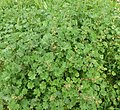Malva nicaeensis
Species of flowering plant From Wikipedia, the free encyclopedia
Malva nicaeensis is a species of flowering plant in the mallow family known by the common names bull mallow[1] and French mallow.[2] It grows up to 60 centimetres (24 in) tall, producing pinkish flowers. It grows in the Middle East, where it has variously served as food.
| Malva nicaeensis | |
|---|---|
 | |
| Scientific classification | |
| Kingdom: | Plantae |
| Clade: | Tracheophytes |
| Clade: | Angiosperms |
| Clade: | Eudicots |
| Clade: | Rosids |
| Order: | Malvales |
| Family: | Malvaceae |
| Genus: | Malva |
| Species: | M. nicaeensis |
| Binomial name | |
| Malva nicaeensis | |
| Synonyms | |
|
Malva arvensis | |
Description
Malva nicaeensis is an annual or biennial herb producing a hairy, upright stem up to 60 centimetres (24 in) long.[3] The leaves are up to 12 cm (4+1⁄2 in) wide and have several slight lobes along the edges.
Flowers appear in the leaf axils, each with pinkish to light purple petals around 1 cm (1⁄2 in) long. The disc-shaped fruit has several segments.
Distribution and habitat
In the Levant, mallows grow profusely after the first winter rains.
Uses
The leaves and stems are edible, and are widely collected for food, as they make an excellent garnish when chopped and fried in olive-oil with onions and spices. In Israel, the plant is renowned for having fed the besieged Jewish population in the 1948 Battle for Jerusalem, its use similar to spinach. A particularly famous preparation are the Khubeza patties. Apicius, a collection of Roman cookery recipes, mentions garum being used as a fish stock to flavor cooked mallows.[4]
Botanical gallery
- Plant form, general
- Plant form closer
- Epicalyx 3 broad segments, lacking stellate hairs
- Flower, pinky with bold veins, may be paler
- Flower showing calyx with 5 broad parts, epicalyx with 3 broad parts, sparsely hairy with simple hairs
- Flower, petals without hairs, or with little, at centre
- Central stigma
- Petal, no hairs or scarcely so
- Fruit, lightly hairy (may be hairless), showing wrinkles
- Fruit, very hairy form
- Flowers showing features together
- Bracts
- Plant area
- Leafage area
- Leaf
- Leaf upperside
- Leaf underside
- Hairs generally simple with conspicuous bulbous bases (as M. sylvestris)
- Plant base
- Plant base
References
External links
Wikiwand - on
Seamless Wikipedia browsing. On steroids.




















